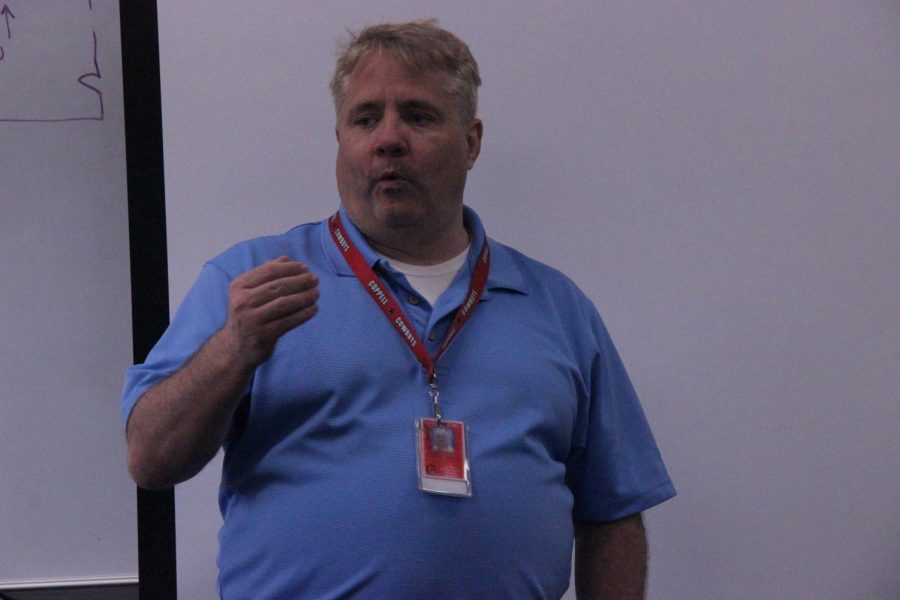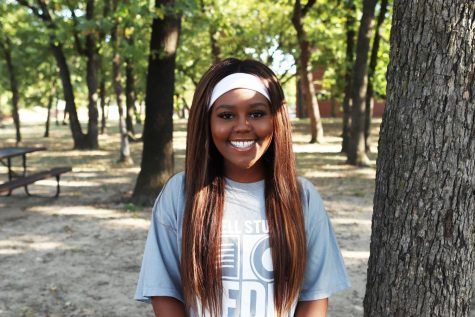February Teacher of the Issue: Dixon chalking it up to experience
Coppell High School AP World History teacher Tim Dixon discusses the do’s and don’ts for a thesis statement during his second period AP World History class on Thursday. Dixon previously served in the military and as a wrestling coach and was named The Sidekick’s February teacher of the issue.
February 15, 2020
The sound of chalk on a blackboard melds with the sound of a presentation, connections drawn between different periods and events in the expanse of time. Having spent time as a member of the military and wrestling coach, Coppell High School AP World History teacher and academic decathlon coach Tim Dixon brings a different approach to his teaching – ranging from chalkboard lectures to related current events from the The New York Times, which he tweets out from his account @Vladstock.
What makes your class unique?
I really feel that anything in history – 100 years ago, 500 years ago, 1,000 years ago – it’s still happening today. Kids should see history isn’t old fuddy duddy stuff, it’s still actually going on and it’s happening in this world. That’s why we incorporate current events with it. Some kids love that, some kids say they wish they would have spent more time with actual content for the AP test. I just personally feel you got to know current events and that in every single article, there’s history and I can connect it to history. Society’s values that have gone on for 500 years created a situation that’s happening in the news.
What was your transition like after your time in the Army?
It’s softening and weakening and letting your guard down. I used to be more hardcore, a little bit more abrasive. It’s funny because people even think I’m that way now and I’m like, “Man, it’s like, not only is it not close to what I used to be, it was pretty rough around the edges.” But I wasn’t as rough as any of my friends. They were much rougher than I was. So in my world, where I was out in Nebraska was infantry. It was tough guys who hunt. Guys are outdoorsmen, they’ve been in the military, getting in fights and it was kind of something we did in college. And it was just rough around the edges but I wasn’t near as rough. And when you become a teacher, all of a sudden all that starts to go away, you know…I make a joke in class about dewimpification. So I always tell kids we got to dewimpify. Our kids here are raised more academically, you’re raised anti-bullying, you’re raised how to open doors and be more respectful, and I know a lot of kids wouldn’t agree with this but it’s light years better than how I was brought up. And so, I always made a joke that if any kid would do something tough, we’ll give you dewimpification points. So if you got hurt playing a sport, you got dewimpification points. I had a kid go fishing and the fish hook got stuck in the skin. And I said, “Did you cry?” and he said no. OK, we got 10 dewimpification points. It was always just a running joke.
How did you get your Twitter handle, @Vladstock?
Gosh, so funny because [there] was a revolution going on in Iran in 2009 called the Green Revolution. It was just so amazing. I really thought they were gonna overthrow the ayatollah, thought maybe the U.S. should intervene. Obama was our president, and he’d be more of a noninterventionist. I know we probably wouldn’t, and whether that’s the right thing or wrong thing doesn’t matter. It was just interesting news. But the problem is, it all went away. CNN stopped reporting, Fox News stopped reporting, ABC stopped reporting, nobody was reporting. It just went blank, I couldn’t believe it.
So somebody had a website that had a collage of tweets [from Iranian protesters]. I didn’t [have a Twitter], I had no clue how to operate any of this. I didn’t know what a Twitter account was. People from Iran were sending tweets out because they videotaped the revolution, and then they’d run into an internet cafe, and they’d upload it and they set it up via satellite. So, all these people take it on their cell phone and then they run to the internet cafe and send it out. And that’s how all the information was getting there.
One thing led to another and I eventually figured out what Twitter was, so I created my Twitter account – but I was afraid that maybe Iranian terrorists would locate me for researching because I was scared about the internet. I just didn’t want to be identified so I thought, “I have got to come up with a name.” My name was Vladivostok, which I always tell kids in my classroom is my favorite city name to yell. Vladivostok is a warm water report for Russia and the Pacific Ocean. I love to kind of make fun of that name. So my Twitter handle was Vlad. Then the middle initial E. Vladstock. And I put on there that I was from Tehran, Iran. That way if any terrorist saw me, they think, “Oh we need to go look for him in Tehran.” I really didn’t know any of this stuff, I was just scared, I didn’t want anyone to know who I was. So that was my Twitter handle and I followed that revolution, which was unbelievable because now that I’m on Twitter, they were doing live updates and you would actually follow the procession down the street, when they’re attacking the police, when they’re getting attacked, it was unbelievable.
Follow Sally (@sparampottil) and @CHSCampusNews on Twitter.











